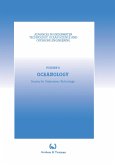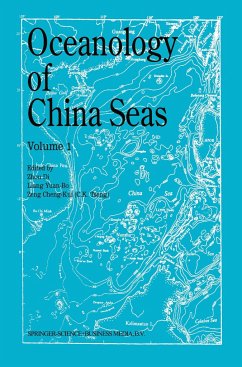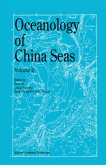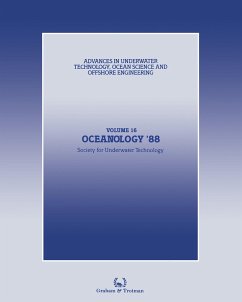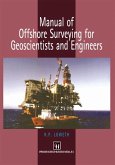Society for Underwater Technology (SUT)
Oceanology
Proceedings of an International Conference (Oceanology International '86), Sponsored by the Society for Underwater Technology, and Held in Brighton, Uk, 4-7 March 1986
Society for Underwater Technology (SUT)
Oceanology
Proceedings of an International Conference (Oceanology International '86), Sponsored by the Society for Underwater Technology, and Held in Brighton, Uk, 4-7 March 1986
- Gebundenes Buch
Andere Kunden interessierten sich auch für
![Oceanology Oceanology]() Society for Underwater Technology (SUT)Oceanology166,99 €
Society for Underwater Technology (SUT)Oceanology166,99 €![Oceanology of China Seas Oceanology of China Seas]() Oceanology of China Seas74,99 €
Oceanology of China Seas74,99 €![Oceanology of China Seas Oceanology of China Seas]() Zhou Di / Liang Yan-Bo / Zeng Cheng-Kui (C.K. Tseng) (Hgg.)Oceanology of China Seas83,99 €
Zhou Di / Liang Yan-Bo / Zeng Cheng-Kui (C.K. Tseng) (Hgg.)Oceanology of China Seas83,99 €![Ocean Colour: Theory and Applications in a Decade of CZCS Experience Ocean Colour: Theory and Applications in a Decade of CZCS Experience]() Ocean Colour: Theory and Applications in a Decade of CZCS Experience83,99 €
Ocean Colour: Theory and Applications in a Decade of CZCS Experience83,99 €![Oceanology '88 Oceanology '88]() Society for Underwater Technology (SUT)Oceanology '88113,99 €
Society for Underwater Technology (SUT)Oceanology '88113,99 €![Oceanology '88 Oceanology '88]() Society for Underwater Technology (SUT)Oceanology '8842,99 €
Society for Underwater Technology (SUT)Oceanology '8842,99 €![Manual of Offshore Surveying for Geoscientists and Engineers Manual of Offshore Surveying for Geoscientists and Engineers]() R. P. LowethManual of Offshore Surveying for Geoscientists and Engineers110,99 €
R. P. LowethManual of Offshore Surveying for Geoscientists and Engineers110,99 €-
-
-
Produktdetails
- Advances in Underwater Technology, Ocean Science and Offshore Engineering 6
- Verlag: Springer / Springer Netherlands
- Artikelnr. des Verlages: 978-0-86010-772-9
- 1986.
- Seitenzahl: 486
- Erscheinungstermin: 28. Februar 1986
- Englisch
- Abmessung: 254mm x 178mm x 27mm
- Gewicht: 1170g
- ISBN-13: 9780860107729
- ISBN-10: 0860107728
- Artikelnr.: 24657403
Hinweis: Dieser Artikel kann nur an eine deutsche Lieferadresse ausgeliefert werden.
- Herstellerkennzeichnung
- Produktsicherheitsverantwortliche/r
- Europaallee 1
- 36244 Bad Hersfeld
- gpsr@libri.de
I Navigation.- 1 Modern navigation and positioning techniques.- 2 Equipment for differential GPS.- 3 The application of fast parallel processing to enhance the performance of navigation systems.- 4 Comparisons of dynamic surface positioning systems.- II Environmental Observations.- 5 Oceanographic and remote sensed data bases at national and international level (not submitted for publication).- 6 A review of the ODAP project: 1980-1985.- 7 Wave measurements at North Atlantic weather stations "India" and "Juliett" in the 1970s.- 8 The advantages and problems of using acoustic Doppler current profilers in support of exploration drilling on the West Shetland Continental Shelf.- 9 Utilization of "Service Argos" for the remote monitoring of oceanographic data acquisition systems.- III Underwater Vehicle Applications.- 10 An advanced underwater towed vehicle for oceanographic measurements.- 11 Methods for reducing ship-induced attitude variations of passive towed bodies.- 12 Long-range underwater acoustic image transmitting system.- 13 Operational aspects of swimming and seabed crawling ROVs for search and salvage of lost dangerous cargo.- 14 The Arcs and Dolphin untethered remotely operated vehicles.- IV Environmental Modelling.- 15 Activities of the WAM (Wave Modelling) Group.- 16 On the application of MIROS data in ocean wave modelling.- 17 Estimating extreme still-water levels and currents offshore.- 18 A forecasting method of typhoon swell.- 19 Numerical wave models as a source of data for marine climatology.- V Geology/Geophysics/Geotechnics.- 20 A new opto-electronic technique for the measurement of seabed sand transport.- 21 RALPHNET: an underwater local area network.- 22 The Benigraph System: results of field trials.- 23 Two-ship undershooting of aproduction platform.- 24 A three-component ocean bottom microprocessor-based seismometer.- VI Wave Directionality.- 25 The wavescan second generation directional wave buoy: from design concepts to field testing.- 26 Field results comparing two directional wave buoys.- 27 SPEAR-F (a wave height spectrum buoy via ARGOS) and the directional wave height measuring buoys at IFREMER.- VII Geology/Geophysics/Geotechnics.- 28 SeaLion: A Snellius-II expedition system for in situ geotechnical testing in water depths of 6000m.- 29 Effect of time after sampling on laboratory test results.- 30 PUPPI - a free-fall seabed piezometer for geotechnical studies.- 31 Conventional geotechnical approach to marine geotechnical applications: a perspective.- VIII Loading Actions.- 32 A technique for estimating wave-induced motion responses of a crane barge semi-submersible.- 33 Intercomparison tests related to the application of drift buoy systems for Lagrangian current measurements in the Yellow Sea.- 34 Use of optical-fibre sensors for crack detection in marine environments.- IX Geology/Geophysics/Geotechnics.- 35 The collection, interpretation and presentation of geotechnical data for marine pipeline projects.- 36 Pipeline inspections: an overview.- 37 Analyses of instability of seabed and substrate in the East China Sea.- 38 Channels in the North Sea: the nature of a hazard.- 39 Pockmarks of the Northwestern Arabian Gulf.- X Hydrography - Instrumentation.- 40 Computer-aided mapping of sonar.- 41 SONARMAP: a convenient integration of positioning information and seafloor mapping sonar data.- 42 An automatic hydrographie survey system with digital charting facilities (not submitted for publication).- 43 Multibeam echo-sounder system for seabed mapping.- 44 The Bathymétric swathe soundingsystem.- XI Hydrography - Dredging/MUD/General.- 45 High-accuracy dredging surveys at the Port of Hamburg.- 46 Nautical bottom research and survey for optimisation of maintenance dredging in mud areas.- 47 A vessel-borne gamma-ray slit density gauge for the in-situ examination of sediments.- 48 Hovercraft in surveying.- 49 Hydrographic surveying education in Nigeria.- 50 Doubtful hydrographic data.- 51 A seismic cone penetrometer for offshore applications.
I Navigation.- 1 Modern navigation and positioning techniques.- 2 Equipment for differential GPS.- 3 The application of fast parallel processing to enhance the performance of navigation systems.- 4 Comparisons of dynamic surface positioning systems.- II Environmental Observations.- 5 Oceanographic and remote sensed data bases at national and international level (not submitted for publication).- 6 A review of the ODAP project: 1980-1985.- 7 Wave measurements at North Atlantic weather stations "India" and "Juliett" in the 1970s.- 8 The advantages and problems of using acoustic Doppler current profilers in support of exploration drilling on the West Shetland Continental Shelf.- 9 Utilization of "Service Argos" for the remote monitoring of oceanographic data acquisition systems.- III Underwater Vehicle Applications.- 10 An advanced underwater towed vehicle for oceanographic measurements.- 11 Methods for reducing ship-induced attitude variations of passive towed bodies.- 12 Long-range underwater acoustic image transmitting system.- 13 Operational aspects of swimming and seabed crawling ROVs for search and salvage of lost dangerous cargo.- 14 The Arcs and Dolphin untethered remotely operated vehicles.- IV Environmental Modelling.- 15 Activities of the WAM (Wave Modelling) Group.- 16 On the application of MIROS data in ocean wave modelling.- 17 Estimating extreme still-water levels and currents offshore.- 18 A forecasting method of typhoon swell.- 19 Numerical wave models as a source of data for marine climatology.- V Geology/Geophysics/Geotechnics.- 20 A new opto-electronic technique for the measurement of seabed sand transport.- 21 RALPHNET: an underwater local area network.- 22 The Benigraph System: results of field trials.- 23 Two-ship undershooting of aproduction platform.- 24 A three-component ocean bottom microprocessor-based seismometer.- VI Wave Directionality.- 25 The wavescan second generation directional wave buoy: from design concepts to field testing.- 26 Field results comparing two directional wave buoys.- 27 SPEAR-F (a wave height spectrum buoy via ARGOS) and the directional wave height measuring buoys at IFREMER.- VII Geology/Geophysics/Geotechnics.- 28 SeaLion: A Snellius-II expedition system for in situ geotechnical testing in water depths of 6000m.- 29 Effect of time after sampling on laboratory test results.- 30 PUPPI - a free-fall seabed piezometer for geotechnical studies.- 31 Conventional geotechnical approach to marine geotechnical applications: a perspective.- VIII Loading Actions.- 32 A technique for estimating wave-induced motion responses of a crane barge semi-submersible.- 33 Intercomparison tests related to the application of drift buoy systems for Lagrangian current measurements in the Yellow Sea.- 34 Use of optical-fibre sensors for crack detection in marine environments.- IX Geology/Geophysics/Geotechnics.- 35 The collection, interpretation and presentation of geotechnical data for marine pipeline projects.- 36 Pipeline inspections: an overview.- 37 Analyses of instability of seabed and substrate in the East China Sea.- 38 Channels in the North Sea: the nature of a hazard.- 39 Pockmarks of the Northwestern Arabian Gulf.- X Hydrography - Instrumentation.- 40 Computer-aided mapping of sonar.- 41 SONARMAP: a convenient integration of positioning information and seafloor mapping sonar data.- 42 An automatic hydrographie survey system with digital charting facilities (not submitted for publication).- 43 Multibeam echo-sounder system for seabed mapping.- 44 The Bathymétric swathe soundingsystem.- XI Hydrography - Dredging/MUD/General.- 45 High-accuracy dredging surveys at the Port of Hamburg.- 46 Nautical bottom research and survey for optimisation of maintenance dredging in mud areas.- 47 A vessel-borne gamma-ray slit density gauge for the in-situ examination of sediments.- 48 Hovercraft in surveying.- 49 Hydrographic surveying education in Nigeria.- 50 Doubtful hydrographic data.- 51 A seismic cone penetrometer for offshore applications.


